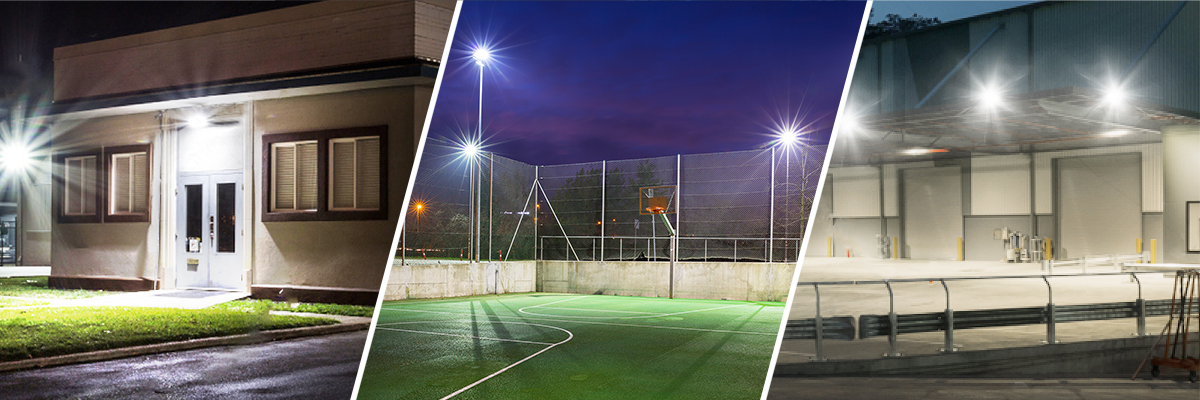
LED flood lights have revolutionized the lighting industry by providing energy-efficient, high-lumen output solutions for various applications. These lights utilize light-emitting diode (LED) technology, which offers superior luminous efficacy, longevity, and thermal management. This comprehensive guide will explore the technical specifications, working principles, benefits, and applications of LED flood lights.
LED flood lights function based on the principle of electroluminescence. When an electric current passes through a semiconductor material, it excites electrons, causing them to release energy in the form of photons. This process generates light with minimal heat production, making LEDs more efficient than traditional lighting sources.
LED Chip: The core light-emitting component of semiconductor materials like Gallium Nitride (GaN).
Heat Sink: A thermal management system that dissipates excess heat, ensuring longevity and performance.
Driver Circuit: Converts AC power to a stable DC voltage required for LED operation.
Optical Lens: Directs and diffuses light for desired beam angles and intensity distribution.
Housing and Enclosure: Made of aluminum or polycarbonate to protect internal components from environmental factors.
Luminous efficacy measures the efficiency of the LED flood light in terms of lumen output per watt. Modern LED flood lights typically range from 100 to 180 lm/W, which is significantly higher than traditional halogen or metal halide lights.
Expressed in Kelvin (K), CCT determines the color appearance of the light:
Warm White (2700K - 3500K): Suitable for aesthetic lighting and indoor applications.
Neutral White (4000K - 5000K): Ideal for general outdoor lighting.
Cool White (5000K - 6500K): Preferred for security and high-visibility areas.
CRI measures the ability of the LED light to render colors accurately in comparison to natural light. LED flood lights generally have a CRI of >80, with premium versions reaching 90+ for applications requiring high color fidelity.
LED flood lights are available in various beam angles to cater to different lighting needs:
Narrow Beam (15° - 30°): Focused lighting for architectural highlighting.
Medium Beam (45° - 60°): General outdoor illumination.
Wide Beam (90° - 120°): Coverage for large areas such as stadiums and parking lots.
The IP rating defines the level of protection against dust and water ingress. Common ratings include:
IP65: Dust-tight and resistant to low-pressure water jets.
IP66: Enhanced water resistance for outdoor applications.
IP67/IP68: Fully waterproof for submersible or extreme weather conditions.
Power factor measures the efficiency of electrical power usage. LED flood lights typically have a PF > 0.90, ensuring minimal energy wastage.
The lifespan of LED flood lights ranges between 50,000 to 100,000 hours, significantly reducing maintenance costs compared to traditional lighting systems.
LED flood lights consume up to 80% less energy compared to conventional lighting, translating to substantial energy savings over time.
With robust materials and superior thermal management, LED flood lights withstand harsh environmental conditions and voltage fluctuations.
Unlike mercury-containing fluorescent lights, LEDs do not emit hazardous substances, making them environmentally sustainable.
Unlike HID lamps that require warm-up time, LED flood lights provide instant full-brightness illumination upon switching on.
Dimmable and tunable LED options allow users to adjust brightness and color temperatures according to specific requirements.
LED flood lights with motion sensors and high-lumen output enhance security in residential, commercial, and industrial areas.
High-power LED flood lights with CRI > 90 and beam angles of 30° - 60° ensure optimal visibility for players and spectators.
Narrow-beam LED flood lights accentuate building facades, monuments, and landscapes with precision lighting.
LED flood lights in 5000K - 6000K CCT improve visibility in warehouses, factories, and manufacturing units.
Wide-beam LED flood lights with IP66 rating and anti-glare optics enhance safety in parking areas and highways.
Flood lights with high CRI and uniform illumination enhance the visibility of advertisements and signboards.
Selecting the appropriate wattage ensures adequate illumination without overconsumption of power:
30W - 50W: Small yards, residential gardens.
100W - 200W: Parking lots, commercial areas.
300W - 1000W: Stadiums, large industrial complexes.
Advanced LED flood lights integrate with DALI, Zigbee, and IoT-based smart controls for remote operation and automation.
A built-in surge protector (4kV - 10kV) prevents damage from voltage spikes and fluctuations.
Die-cast aluminum housing with fin-type heat sinks ensures effective thermal management for extended lifespan.
Ensure compliance with RoHS, CE, UL, and DLC certifications for safety and energy efficiency.
LED flood lights offer unparalleled advantages in terms of efficiency, durability, and adaptability across various applications. With advancements in smart lighting, adaptive optics, and enhanced thermal management, they continue to be the preferred choice for modern illumination needs. When selecting an LED flood light, considering factors such as luminous efficacy, beam angle, IP rating, and smart control capabilities will ensure optimal performance and long-term benefits.
